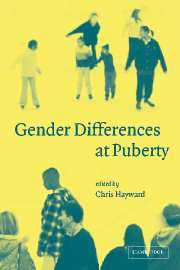Book contents
- Frontmatter
- Contents
- List of figures
- List of tables
- List of contributors
- Preface
- Acknowledgments
- 1 Methodological concerns in puberty-related research
- Part 1 Sex differences in hormones and their effect at puberty
- 2 The biology of puberty: new developments in sex differences
- 3 Hormonal changes at puberty and the emergence of gender differences in internalizing disorders
- Part 2 Girls at puberty
- Part 3 Boys at puberty
- Part 4 Puberty and psychopathology
- Part 5 Pubertal timing: antecedents
- Part 6 Pubertal timing: consequences
- Part 7 Puberty and context
- Index
- References
3 - Hormonal changes at puberty and the emergence of gender differences in internalizing disorders
Published online by Cambridge University Press: 22 September 2009
- Frontmatter
- Contents
- List of figures
- List of tables
- List of contributors
- Preface
- Acknowledgments
- 1 Methodological concerns in puberty-related research
- Part 1 Sex differences in hormones and their effect at puberty
- 2 The biology of puberty: new developments in sex differences
- 3 Hormonal changes at puberty and the emergence of gender differences in internalizing disorders
- Part 2 Girls at puberty
- Part 3 Boys at puberty
- Part 4 Puberty and psychopathology
- Part 5 Pubertal timing: antecedents
- Part 6 Pubertal timing: consequences
- Part 7 Puberty and context
- Index
- References
Summary
As puberty is the most salient developmental milestone occurring during adolescence, there is speculation about the differential effects of puberty on the emergence of gender differences in internalizing disorders (depressive anxiety and eating disorders) during adolescence. Prior to adolescence the rates of internalizing disorders are slightly higher in boys or equal to that for girls. In early adolescence the rates of girls' internalizing disorders rise to at least two times those for boys (Angold and Worthman, 1993; Silberg, et al., 1999). Several authors have attempted to establish whether the key factor in the increase of internalizing symptoms and disorders during early adolescence is more linked to puberty specifically, or to increasing age (Angold, Costello, and Worthman, 1998; Angold and Rutter, 1992; Brooks-Gunn and Warren, 1989; Hayward, et al., 1999; Hayward, et al., 1992; Killen, et al., 1992; Paikoff, Brooks-Gunn, and Warren, 1991; Patton, Hibbert, and Carlin, 1996; Rutter, et al., 1989; Rutter, Tizard, and Whitmore, 1970; Susman, et al., 1987a; Warren and Brooks-Gunn, 1989; see chapter 8). Most studies comparing age effects and puberty effects in peri-pubertal adolescent girls have found an association with puberty but not with age in the emergence of internalizing symptoms and disorders. In a study of sixth and seventh grade girls, the relative importance of pubertal stage and age in frequencies of anxiety and eating disorder symptoms were compared (Hayward, et al., 1992; Killen, et al., 1992).
- Type
- Chapter
- Information
- Gender Differences at Puberty , pp. 29 - 58Publisher: Cambridge University PressPrint publication year: 2003
References
- 11
- Cited by



